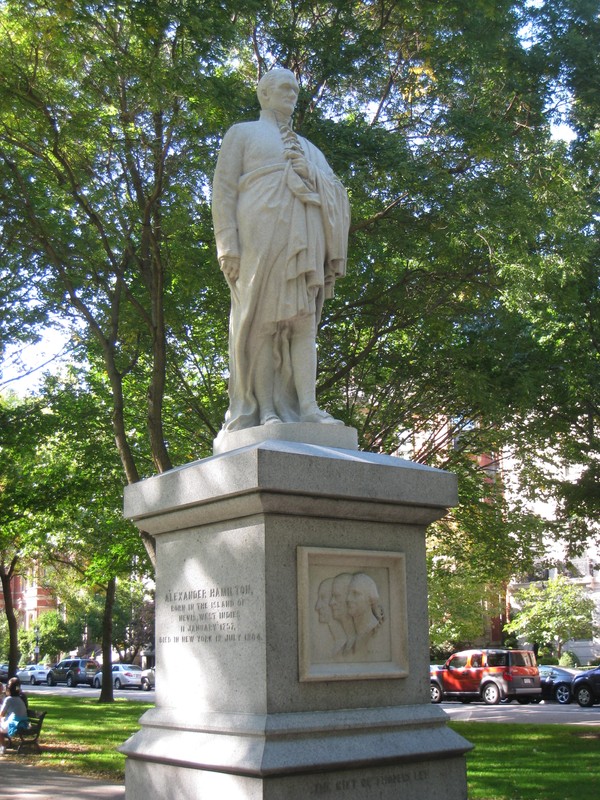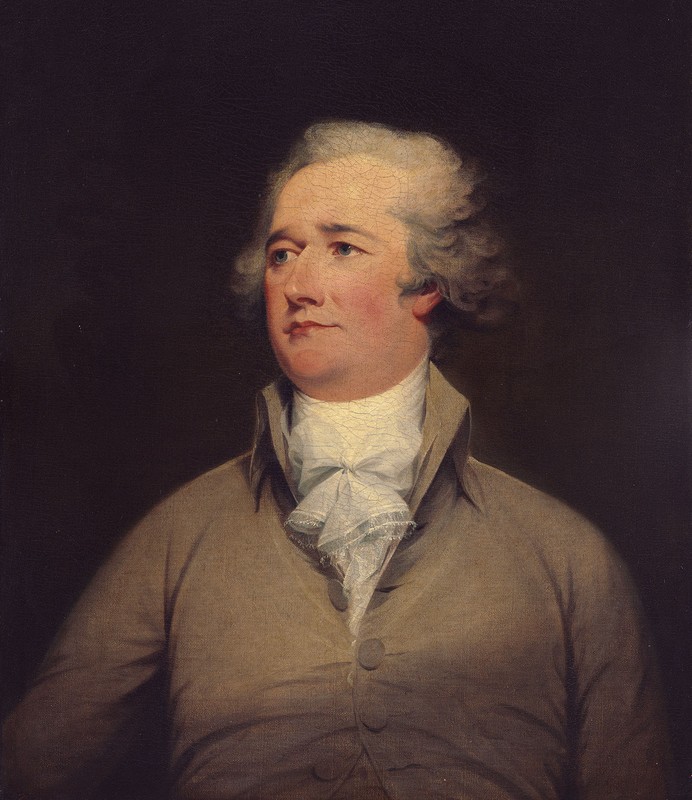Alexander Hamilton Statue
Introduction
Text-to-speech Audio
Images
Alexander Hamilton Statue on Boston's Commonwealth Avenue Mall

Alexander Hamilton (1755/1757-1804)

Backstory and Context
Text-to-speech Audio
Alexander Hamilton was born out of wedlock to James Hamilton and Rachel Faucette in January of either 1755 or 1757 on the British-held Caribbean island of Nevis. In 1766, James Hamilton abandoned Faucette and their two sons, James and Alexander. Faucette then moved with her sons to St. Croix, which at the time was part of the Danish West Indies. In 1768, Hamilton’s mother died, leaving him and his older brother orphaned. While working as a clerk on St. Croix, Hamilton wrote and published an eloquent letter describing a hurricane that hit the island in 1772. Recognizing the young man’s superior intellect and desirous to see him reach his full potential, residents of St. Croix raised enough money to send him to the British North American colonies to receive an education.
Hamilton arrived in the American colonies in late 1772. Despite initially applying for admission to the College of New Jersey (now Princeton University), he ultimately enrolled at King’s College in New York City (now Columbia University). During his time there, Hamilton became sympathetic to colonial criticisms of British imperial policy, going so far as to write several pamphlets challenging loyalist views. When the American Revolution broke out, he first drilled with a New York militia company before becoming captain of an artillery company in March 1776. While serving with the unit, Hamilton participated in several of the conflict’s early engagements, including the Battle of Trenton. Eventually, he caught the eye of General George Washington, who offered Hamilton a position on his staff. The young patriot accepted and received a promotion to the rank of lieutenant colonel. In 1780, Hamilton wed Elizabeth Schuyler, the daughter of Philip Schuyler, a wealthy New Yorker and general in the Continental Army. The following year, after a spat with Washington over not yet receiving a field command, Hamilton resigned his position. Despite the quarrel and resignation, Washington granted him his wish and assigned him a field command. During the Siege of Yorktown in October 1781, Hamilton proved himself in battle when he led a successful assault on a British defense, which helped lead to General Lord Cornwallis’s eventual surrender.
After the war, Hamilton read law, passed the bar, and started a law practice in New York City. He also served as a New York delegate to the Confederation Congress in 1782 and the Constitutional Convention five years later. A supporter of the Constitution’s ratification, he coauthored the Federalist Papers along with James Madison and John Jay. When George Washington became the first President of the United States, he appointed Hamilton the nation’s first secretary of the treasury. Before Washington left office, Hamilton helped the Virginian draft his famous farewell address.
On the morning of July 11, 1804, Hamilton met Aaron Burr in Weehawken, New Jersey for a duel. Trouble between the two men had been brewing for nearly fifteen years. In 1791, the New York State Legislature chose Burr to represent the state in the U.S. Senate rather than returning Hamilton’s father-in-law, incumbent Philip Schuyler, to Washington, D.C. Nine years later, when the presidential election resulted in an electoral tie between Burr and Thomas Jefferson, Hamilton threw his support behind Jefferson, helping him capture the presidency at Burr’s expense. In 1804, during the New York gubernatorial election, an Albany newspaper published a letter claiming that Hamilton had insulted Burr, a candidate in the election, at a private dinner party. After losing the election, Burr confronted Hamilton and challenged him to a duel. During the illegal affair, Hamilton suffered a gunshot wound to the stomach and died the following day.
More than half a century later, Boston resident and art patron Thomas Lee commissioned artist William Rimmer to complete a statue of Hamilton, which he intended to donate as a gift to the City of Boston. Carved from a solid block of granite, the over-life-sized sculpture depicts Hamilton standing, dressed in period clothing with drapery slung over his left arm and wrapped around his waist. Dedicated on August 24, 1865 on Commonwealth Avenue Mall, it rests on a granite pedestal inset with three overlapping left profile bust reliefs of George Washington, Hamilton, and John Jay.
Sources
"Alexander Hamilton, (sculpture)." Art Inventories Catalog. Smithsonian American Art Museum. Smithsonian Institution Research Information System (SIRIS). Web. 29 May 2021 <https://siris-artinventories.si.edu/ipac20/ipac.jsp?&profile=ariall&source=~!siartinventories&uri=full=3100001~!18433~!0#focus>.
History.com Editors. "Alexander Hamilton." History. A&E Television Networks. 16 October 2020. Web. 29 May 2021 <https://www.history.com/topics/american-revolution/alexander-hamilton>.
Kirstein, Lincoln. "William Rimmer: His Life and Art." The Massachusetts Review 2, no. 4 (Summer 1961): 685-716.
O'Keefe, Kieran J. "Alexander Hamilton." George Washington's Mount Vernon. Mount Vernon Ladies' Association. Web. 29 May 2021 <https://www.mountvernon.org/library/digitalhistory/digital-encyclopedia/article/alexander-hamilton/>.
https://itshamiltime.com/2013/09/20/images-of-hamilton-william-rimmer-statue-in-boston/
https://www.britannica.com/biography/Alexander-Hamilton-United-States-statesman
